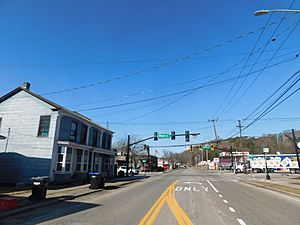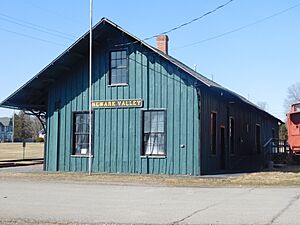Newark Valley (village), New York facts for kids
Quick facts for kids
Newark Valley
|
|
|---|---|
|
Village
|
|

NY 38 northbound in Newark Valley.
|
|
| Country | United States |
| State | New York |
| County | Tioga |
| Settled | 1791 |
| Incorporated | September 1894 |
| Named for | Newark, New Jersey |
| Area | |
| • Total | 0.99 sq mi (2.56 km2) |
| • Land | 0.99 sq mi (2.56 km2) |
| • Water | 0.00 sq mi (0.00 km2) |
| Elevation | 968 ft (295 m) |
| Population
(2020)
|
|
| • Total | 928 |
| • Density | 939.27/sq mi (362.73/km2) |
| Time zone | UTC-5 (Eastern (EST)) |
| • Summer (DST) | UTC-4 (EDT) |
| ZIP code |
13811
|
| Area code(s) | 607 |
| FIPS code | 36-49902 |
| GNIS feature ID | 0958490 |
Newark Valley is a small village located in Tioga County, New York, United States. It is part of the larger Binghamton area. The village gets its name from the city of Newark, New Jersey. In 2020, about 928 people lived here.
Newark Valley is in the western part of the Town of Newark Valley. It is located northwest of Binghamton.
History
The first settlers arrived in the area around 1792. Many of these early settlers came from New England. However, the village was named after a suggestion from someone from Newark, New Jersey.
The village of Newark Valley officially became a village in 1894.
Several important buildings and places in Newark Valley are listed on the National Register of Historic Places. This means they are special and protected because of their history. Some of these include:
- The Hope Cemetery and Mausoleum
- The Knapp House
- The Newark Valley Municipal Building and Tappan-Spaulding Memorial Library
- The Nowland House
- The Gilbert E. Purple House
- The Silk Street Bridge
- The Sutton-Chapman-Howland House
Geography
Newark Valley covers about 1.0 square mile (2.5 square kilometers) of land. There is no water area within the village limits.
The village is located in the valley of the East Branch of Owego Creek. Main Street, also known as Route 38, runs through the village. It is north of the junction with NY-38B.
Population Information
| Historical population | |||
|---|---|---|---|
| Census | Pop. | %± | |
| 1890 | 875 | — | |
| 1900 | 818 | −6.5% | |
| 1910 | 925 | 13.1% | |
| 1920 | 821 | −11.2% | |
| 1930 | 795 | −3.2% | |
| 1940 | 949 | 19.4% | |
| 1950 | 1,027 | 8.2% | |
| 1960 | 1,234 | 20.2% | |
| 1970 | 1,286 | 4.2% | |
| 1980 | 1,190 | −7.5% | |
| 1990 | 1,082 | −9.1% | |
| 2000 | 1,071 | −1.0% | |
| 2010 | 997 | −6.9% | |
| 2020 | 928 | −6.9% | |
| U.S. Decennial Census | |||
In 2000, there were 1,071 people living in the village. Most of the residents were White (97.67%). A small number of people were African American, Native American, or from other backgrounds. About 1.31% of the population was Hispanic or Latino.
There were 390 households in the village. About 37.7% of these households had children under 18 living with them. The average household had 2.58 people.
The population was spread out by age. About 29.7% of the people were under 18 years old. About 14.3% were 65 years or older. The average age in the village was 36 years.
Education
Newark Valley is home to the Newark Valley Central School District. This is a public school system. It includes an elementary school, a middle school, and a high school. On average, about 100 students graduate from the high school each year.
See also
 In Spanish: Newark Valley (villa) para niños
In Spanish: Newark Valley (villa) para niños



